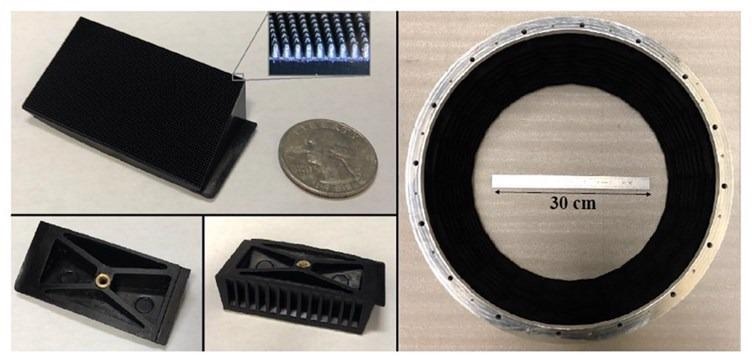Jan 27 2021
New metamaterial tiles designed by a multi-institutional research team will help enhance the sensitivity of telescopes that are being constructed at the distinguished Simons Observatory in Chile.
 Researchers developed new metamaterial tiles that will improve the sensitivity of telescopes at the Simons Observatory by absorbing stray light. The top left photo shows one tile, with its anti-reflective surface shown in the insert. The bottom left photos show the back of the tile, and the right photo shows the assembly of 240 tiles installed on the wall of an optics tube. Image Credit: Zhilei Xu, University of Pennsylvania.
Researchers developed new metamaterial tiles that will improve the sensitivity of telescopes at the Simons Observatory by absorbing stray light. The top left photo shows one tile, with its anti-reflective surface shown in the insert. The bottom left photos show the back of the tile, and the right photo shows the assembly of 240 tiles installed on the wall of an optics tube. Image Credit: Zhilei Xu, University of Pennsylvania.
The metamaterial tiles have been integrated into receivers that will be installed at the Simons Observatory by 2022.
The Simons Observatory is the core of an ambitious attempt to quantify the background of cosmic microwaves—that is, the remnant of electromagnetic radiations from an early phase of the universe—utilizing some of the most advanced and largest ground-based telescopes in the world.
Such measurements will help enhance one’s interpretation of how the universe started, what it is composed of, and how it emerged into what it is today.
The Simons Observatory telescopes will use a new ultra-sensitive millimeter-wave camera to measure the afterglow of the big bang with unprecedented sensitivity. We developed a new low-cost absorbing tile that will be used in the camera to absorb environmental emissions that can obscure the signals we want to measure.
Zhilei Xu, Study Lead Author, University of Pennsylvania
The researchers have demonstrated that their newly developed metamaterial microwave tiles absorb over 99% of millimeter-wave radiation and retain their absorptive characteristics at very low temperatures, where the millimeter-wave camera works. The study was published in Applied Optics, the journal of the Optical Society (OSA).
Because the tiles can be made by injection molding commercially available materials, they are an economic, mass-producible and easy-to-install solution to what has been a long-standing problem.
Zhilei Xu, Study Lead Author, University of Pennsylvania
Xu added, “With this technology, the Simons Observatory will transform our understanding of the universe from many aspects, including the beginning of the universe, the formation and evolution of the galaxies and the ignition of the first stars.”
Working at Low Temperatures
Receivers that are cooled to cryogenic temperatures are used by ground-based millimeter-wave telescopes to decrease noise and thus increase sensitivity.
Receiver technology has improved to such an extent that any proportion of stray light can deteriorate the image and, at the same time, decrease the detector sensitivity. Therefore, a better method to inhibit stray light inside the receivers would additionally boost their sensitivity to the extremely weak signals emerging from deep within space.
But it is quite difficult to design a material that can inhibit the stray light and still work at such extremely low temperatures. Prior efforts have led to materials that either did not achieve the required combination of high absorption or low reflectance or could not be cooled effectively to cryogenic temperatures. There were other solutions but these also demonstrated to be difficult to produce at a large scale or hard to install.
To resolve these difficulties, the team focused on metamaterials because these materials can be designed to acquire particular characteristics that do not occur in nature. Following complex electromagnetic simulation analyses, the team developed metamaterials based on a material that integrated plastic and carbon particles.
Reducing Reflection
While the plastic composite displayed high absorption in the required microwave area of the electromagnetic spectrum, the surface of this composite reflected a considerable level of radiation before it could enter the material to be absorbed. Hence, to decrease this reflection, the team applied an anti-reflective coating that was customized with the help of injection molding.
The low-reflectance surface combined with high-absorption bulk material allowed the metamaterial absorber tiles to deliver excellent suppression of unwanted signals at cryogenic temperatures close to absolute zero.
Zhilei Xu, Study Lead Author, University of Pennsylvania
After making sure that the new metamaterial tiles could mechanically withstand thermal cycles from cryogenic temperatures to room temperatures, the investigators confirmed that these tiles could be effectively cooled to −458° F (−72 °C), and subsequently quantified their optical performance.
“We developed a custom test facility to measure the performance of the tiles with high fidelity,” stated Grace Chesmore, a graduate student from the University of Chicago who headed the optical measurements of this study.
The testing demonstrated that the metamaterial shows exceptional reflectance characteristics with low scattering and that it also absorbed virtually all of the incoming photons.
“As detector sensitivity continues to improve for millimeter-wave telescopes, it becomes crucial to control scattered photons. The successful combination of a metamaterial and injection molding manufacturing opens up many possibilities for millimeter-wave instrument scientific instrument design,” Xu concluded.
The study was the outcome of a large international teamwork that included scientists from the University of Pennsylvania, the University of Chicago, Goddard Space Flight Center, Massachusetts Institute of Technology, and other institutions.
Journal Reference:
Xu, Z., et al. (2021) The Simons Observatory: metamaterial microwave absorber and its cryogenic applications. Applied Optics. doi.org/10.1364/AO.411711.